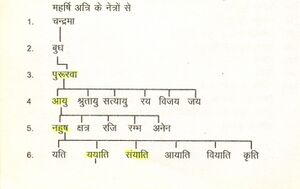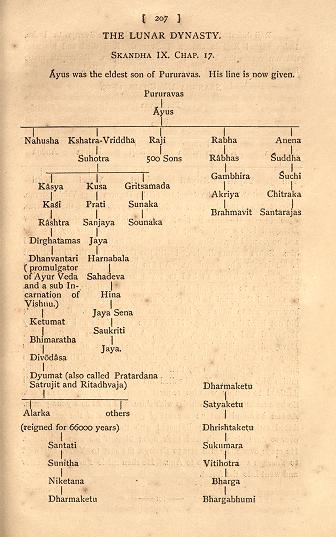Pururava


Pururava (पुरूरवा) was the first king of the Aila dynasty or the Somavamsha.
Atri → Chandrama → Budha → Pururava → Ayu → Nahusha → Yayati
Birth of Pururava
Vana Parva, Mahabharata/Book III Chapter 88 tells us that O king, Sanatkumara regardeth that spot visited by Brahmarshis, as also the tirtha Kanakhala (कनखल) (III.88.19) that is near to it, as sacred. There also is the mountain named Puru (पुरु-पर्वत) (III.88.19) which is resorted to by great Rishis and where Pururavas (पुरूरव) (III.88.19) was born, and Bhrigu practised ascetic austerities. For this it is, O king, that asylum hath become known as the great peak of Bhrigutunga (भृगुतुङ्ग) (III.88.20). Near that peak is the sacred and extensive Vadari (बदरी-आश्रम) (III.88.22), that highly meritorious asylum, famed over the three worlds.
- सनत कुमारः कौरव्य पुण्यं कनखलं तथा
- पर्वतश च पुरुर नाम यत्र जातः पुरूरवः (Mahabharata:III.88.19)
- भृगुर यत्र तपस तेपे महर्षिगणसेवितः
- स राजन्न आश्रमः खयातॊ भृगुतुङ्गॊ महागिरिः (Mahabharata:III.88.20)
Jat Gotras from Pururava
Punaria (पुनरिया) gotra of Jats is said to be originated from samrat Pururava (पुरूरवा). [1]
In Vedas

According to the Vedas, he is a mythological entity associated with the Surya (the sun) and Usha (the dawn), and is believed to resided in the middle region of the cosmos. The Rig Veda (X.95.18) states that he was a son of Ila[2] and was a pious king. However, the Mahabharata states that Ila was both his mother and his father. According to the Vishnu Purana, his father was Budha, and he was ancestor of the tribe of Pururavas, from whom descended the Kauravas and Pandavas.
In Puranas
According to the Puranas, Pururavas reigned from Pratisthana (Prayaga). He had six (or seven or eight according to different accounts) sons. The names of these sons are, Ayu (or Ayus), Amavasu,[3] Vishvayu, Shrutayu, Shatayu and Dridhayu. Nahusha, the son of Ayu, is a well-known name in the Rigveda[4]
पुरूरवा की वंशावली
सृष्टी परमपिता ब्रम्हा से उत्पन्न हुई है इसलिए उनके बाद से पुरुवंश की पीढ़ियों का वर्णन इस प्रकार है. आप दिए गए नंबरों से उनकी पीढ़ी का पता लगा सकते है.
- १. परमपिता ब्रम्हा से प्रजापति दक्ष हुए.
- २. दक्ष से अदिति हुए.
- ३. अदिति से बिस्ववान हुए.
- ४. बिस्ववान से मनु हुए जिनके नाम से हम लोग मानव कहलाते हैं.
- ५. मनु से इला हुए.
- ६. इला से पुरुरवा हुए जिन्होंने उर्वशी से विवाह किया और इन्द्र के पद पर भी आसीन हुए.
- ७. पुरुरवा से आयु हुए.
- ८. आयु से नहुष हुए.
- ९. नहुष के बड़े पुत्र यति थे जो सन्यासी हो गए इसलिए उनके दुसरे पुत्र ययाति राजा हुए. ययाति के पुत्रों से ही समस्त वंश चले. ययाति के पांच पुत्र थे. देवयानी से यदु और तर्वासु तथा शर्मिष्ठा से दृहू, अनु, एवं पुरु. यदु से यादवों का यदुकुल चला जिसमे आगे चलकर श्रीकृष्ण ने जन्म लिया. तर्वासु से मलेछ, दृहू से भोज तथा पुरु से सबसे प्रतापी पुरुवंश चला. अनु का वंश ज्यादा नहीं चला.
खांडवप्रस्थ
विजयेन्द्र कुमार माथुर[5] ने लेख किया है कि....खांडवप्रस्थ (AS, p.255) हस्तिनापुर के पास एक प्राचीन नगर था जहां महाभारतकाल से पूर्व पुरुरवा, आयु, नहुष तथा ययाति की राजधानी थी. कुरु की यह प्राचीन राजधानी बुधपुत्र के लोभ के कारण मुनियों द्वारा नष्ट कर दी गई. युधिष्ठिर को, जब प्रारंभ में, द्यूत-क्रीडा से पूर्व, आधा राज्य मिला तो धृतराष्ट्र ने पांडवों से खांडवप्रस्थ में अपनी राजधानी बनाने तथा फिर से उस प्राचीन नगर को बसाने के लिए कहा था. (महाभारत आदि पर्व, 206 दक्षिणात्य पाठ) तत्पश्चात पांडवों ने खांडवप्रस्थ पहुंच कर उस प्राचीन नगर के स्थान पर एक घोर वन देखा. (आदि पर्व: 206, 26-27). खांडवप्रस्थ के स्थान पर ही इंद्रप्रस्थ नामक नया नगर बसाया गया जो भावी दिल्ली का केंद्र बना. खांडवप्रस्थ के निकट ही खांडववन स्थित था जिसे श्रीकृष्ण और अर्जुन ने अग्निदेव की प्रेरणा से भस्म कर दिया. खांडवप्रस्थ का उल्लेख अन्यत्र भी है. पंचविंशब्राह्मण 25,3,6 में राजा अभिप्रतारिन् के पुरोहित द्दति खांडवप्रस्थ में किए गए यज्ञ का उल्लेख है. अभिप्रतारिन् जनमेजय का वंशज था. जैसा पूर्व उद्धरणों से स्पष्ट है, खांडवप्रस्थ पांडवों के पुराने किले के निकट बसा हुआ था. (दे. इंद्रप्रस्थ, हस्तिनापुर)
References
- ↑ Dr Mahendra Singh Arya, Dharmpal Singh Dudee, Kishan Singh Faujdar & Vijendra Singh Narwar: Ādhunik Jat Itihas (The modern history of Jats), Agra 1998, p. 262
- ↑ Misra, V.S. (2007). Ancient Indian Dynasties, Mumbai: Bharatiya Vidya Bhavan, ISBN 81-7276-413-8, p.57
- ↑ Pargiter, F.E. (1972). Ancient Indian Historical Tradition, Delhi: Motilal Banarsidass, pp.85-6.
- ↑ Misra, V.S. (2007). Ancient Indian Dynasties, Mumbai: Bharatiya Vidya Bhavan, ISBN 81-7276-413-8, pp.59-61
- ↑ Aitihasik Sthanavali by Vijayendra Kumar Mathur, p.255
Back to The Ancient Jats

